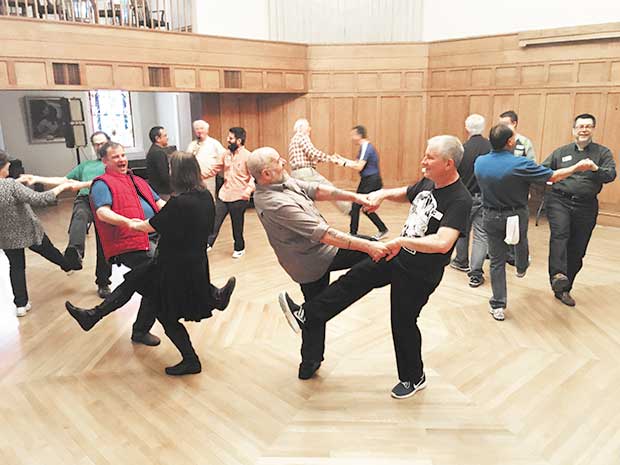Pegasus Squares welcomes LGBT dancers from around the country

Pegasus Square dance at Grace United Methodist Church on Sunday afternoons. (Courtesy Alan Josephson)
DAVID TAFFET | Senior Staff Writer
Pegasus Squares hosts its first regional square dance weekend, with about 100 dancers from around the U.S. set to spend 15 hours swinging their partners around the dance floor of Sons of Hermann Hall in Deep Ellum over the weekend.
The International Association of Gay Square Dance Clubs has about 60 member clubs around the U.S., with more in Canada, Germany and Japan. You’d think Texas would be the state with the most clubs, but Dallas, Austin and San Antonio are the only Lone Star State cities with affiliates.
California, on the other hand, has 20 clubs. And LGBT square dancing is surprisingly popular along the East Coast, with clubs from New York City — the Times Squares — to DelMarVa — the Delmarvelous Squares — to Atlanta to Fort Lauderdale.
Alan Josephson is president of the Pegasus Squares, which has been around for about three years. The group has moved around as it’s grown, but currently dances on Sunday afternoons at Grace United Methodist Church in East Dallas.
Josephson said Pegasus Squares is mostly men, but the club would love to increase its women and transgender membership.
“Almost half the Austin club is lesbian,” Josephson said.
What’s surprising, he added, is the number of straight members the Dallas club attracts.
Josephson explained that in traditional square dancing, the man is expected to be on the left. “I learned to dance the ‘girl’s part’ first,” he said. “So I’ve become bi-dancual.”
But why does a gay square dance club attract straight members? Josephson said the first straight couple attended with friends who are gay. They had so much fun, they stayed.
“The nature of square dancing is turning and moving constantly, so you’re making contact with everyone in the square,” he said. “It’s a non-issue.”
While he invites people who aren’t involved in Pegasus Squares to come and either observe or participate in the weekend, he said square dancing takes some lessons.
“We just finished our fourth set of lessons,” he said.
That set of lessons was just for mainstream dancing, the lowest level of square dance that involves knowing about 70 calls. Josephson said it takes about 15 weeks of lessons to learn those steps. “Plus” is the next level, which adds an additional 30 calls. The top two levels rely on callers putting calls together in new ways to form a variety of combinations.
Bill Eyler is a California-based caller who will be in Dallas for the dance weekend. His love affair with square dancing began in Albuquerque in 1983. He said these weekends like the one Pegasus Squares is hosting are like family reunions.
Eyler said the gay square dance movement began in the ’80s as an offshoot of the Reno Gay Rodeo Association. By the mid-1980s, there were 15 to 20 clubs that had no interaction with straight square dance clubs at all.
The calls were the same, Eyler said, but there wasn’t much mixing.
“By the mid-90s, there was a push to be more accepted,” he said, and the gay clubs hired straight callers.
“The straight callers loved [the gay clubs],” Eyler said. “There was more energy.”
And the straight callers brought in some straight dancers who followed them.
Square dancing is different from other types of dance. One particular song doesn’t set off a particular dance. Instead, dancers follow the instructions of the caller. And the music may be just about anything.
“Very little of the music is western music,” Josephson said. He said he went to one dance where it was mostly ’80s rock. Beyonce is more likely to be heard at a modern square dance than a country-western artist.
But, Eyler explained, whatever the music is, it must be formatted to a 64-beat tempo.
Then, the caller calls the steps. For mainstream level dancers, that may include any of the 70 calls mastered by first level dancers. For more advanced dancers, there are even more calls. Dancers follow the calls and each dance is different.
For the dance at Sons of Hermann, two internationally known callers are coming. They’ll be supplemented by several other callers from around the country, like Eyler. Mixing the callers keeps the many hours of dance fresh.
Josephson said he first became involved in square dance in the mid-1990s when the Big D Longhorns, a previous gay square dance group, was active.
“It was so hokey, I loved it,” he said.
Josephson called square dancing just good, healthy fun, very social with little drinking during the dance. Eyler said his husband began square dancing because it was a great gay bear men’s event.
Last minute registration is $130 and is available online at PegasusSquares.com. The fee includes snacks and some meals through the weekend.















